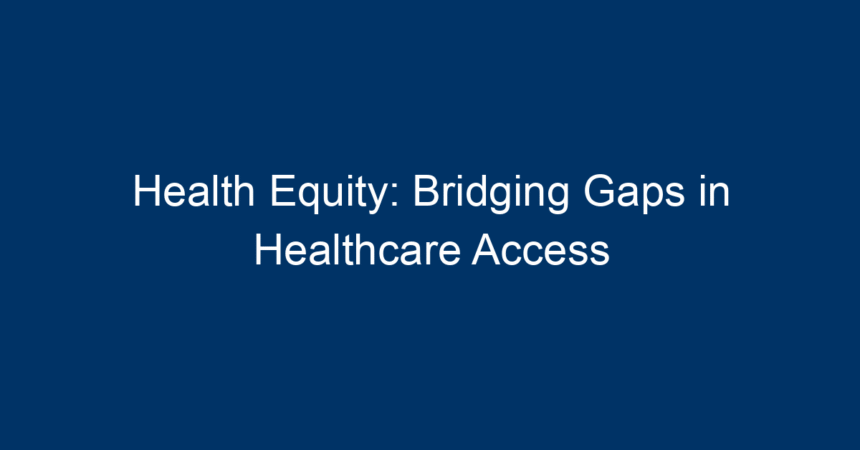In the realm of healthcare, the term health equity has emerged as a critical conversation starter, highlighting the disparities that exist in healthcare access, quality, and outcomes among different populations. While advancements in medical science and technology have improved health services, inequities remain a persistent challenge. This article will explore the concept of health equity, the barriers to achieving it, and actionable strategies to bridge gaps in healthcare access.
Understanding Health Equity
Health equity refers to the idea that everyone should have a fair and just opportunity to attain their highest level of health. This concept acknowledges that social, economic, and environmental factors profoundly influence health. According to the World Health Organization (WHO), health equity goes beyond simply providing equal access to healthcare services; it also requires addressing underlying inequities that shape health outcomes.
The Social Determinants of Health
A significant component of health equity revolves around social determinants of health (SDOH)—the conditions in which people are born, grow, live, work, and age. These determinants include:
- Economic Stability: Individuals with stable employment and income are more likely to access quality healthcare.
- Neighborhood and Built Environment: Safe housing, access to healthy foods, and clean air and water impact health.
- Education: Higher educational attainment correlates with better health literacy and healthier choices.
- Health Care Access: Availability and affordability of healthcare services significantly affect health outcomes.
- Social and Community Context: Relationships and community support contribute to mental and physical health.
Addressing these determinants is vital for promoting health equity and eliminating disparities.
Barriers to Achieving Health Equity
Despite the growing awareness of health equity, several barriers impede progress:
1. Systemic Inequalities
Structural racism, socioeconomic disparities, and geographic location contribute to unequal access to healthcare. Marginalized communities often face systemic barriers that limit their ability to receive timely and appropriate medical care.
2. Economic Constraints
The cost of healthcare remains a significant barrier for many individuals. High insurance premiums, out-of-pocket costs, and the lack of affordable care options can deter people from seeking necessary treatment.
3. Cultural and Language Barriers
Patients from diverse backgrounds may face challenges in navigating a healthcare system that is not culturally competent. Language barriers and a lack of culturally tailored services can lead to miscommunication and inadequate care.
4. Misinformation and Health Literacy
A lack of health literacy can result in poor decision-making regarding health. Misinformation about medical conditions and treatments can exacerbate existing health disparities.
5. Limited Access to Healthcare Facilities
In rural and underserved urban areas, patients may lack access to essential healthcare facilities. This geographical limitation can lead to delays in treatment, worsening health outcomes.
Strategies for Bridging Gaps in Healthcare Access
To promote health equity, it is crucial to implement strategies that address the barriers outlined above. Here are several actionable insights to bridge the gaps in healthcare access:
1. Advocate for Policy Changes
Policy advocacy is essential for addressing systemic health inequities. Engage with lawmakers to promote policies that improve access to healthcare for marginalized populations, such as expanding Medicaid, increasing funding for community health programs, and enforcing anti-discrimination laws.
2. Enhance Community Health Programs
Develop and support community-based health programs that focus on preventative care, education, and culturally competent services. Initiatives like mobile clinics, health fairs, and community workshops can reach underserved populations effectively.
3. Improve Health Literacy
Increasing health literacy involves educating communities about navigating the healthcare system, preventive care, and healthy lifestyle choices. Simplified communication tools, visual aids, and community engagement strategies can facilitate understanding and encourage healthier choices.
4. Promote Cultural Competency in Healthcare
Healthcare providers should receive training in cultural competency to better understand and respond to the unique needs of diverse populations. This includes providing interpreter services and hiring staff from various cultural backgrounds.
5. Invest in Telehealth Services
Telehealth can be a game-changer in improving healthcare access, especially for individuals in remote areas. Expanding telehealth services can help overcome geographical barriers, offering consultations and follow-ups virtually, thus increasing convenience and accessibility.
6. Collaborate with Local Organizations
Partnering with community organizations can enhance outreach efforts, ensuring that health equity initiatives resonate with local needs. Collaborations with non-profits, schools, and faith-based organizations can create a more holistic approach to health promotion.
Conclusion: A Call to Action
Achieving health equity is not just a moral imperative; it is essential for the overall well-being of society. By addressing systemic inequalities and implementing strategies that promote access to quality healthcare for all, we can work towards a healthier future.
As individuals, we can contribute by advocating for policy changes, participating in community health initiatives, and emphasizing the importance of health equity in our conversations. Together, we can bridge the gaps in healthcare access, ensuring that everyone has the opportunity to live a healthy life.
Actionable Insights to Consider:
- Stay Informed: Educate yourself on health disparities that exist in your community.
- Get Involved: Volunteer with organizations that focus on health equity and community health.
- Engage with Decision-Makers: Advocate for health equity policies at local and state levels.
- Support Local Health Initiatives: Participate in or donate to community health programs that aim to reduce disparities.
Together, we can create a future where health is a right, not a privilege, ensuring that every individual enjoys the fullest extent of health and well-being.




